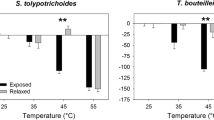Summary
A model was developed to describe interactive effects of exposure time and treatment on thermostability of excisedIllicium parviflorum Michx. root cell membranes using electrolyte leakage (Lc) procedures. Roots were moved from 25°C to treatment temperatures between 35°C and 60°C for 30 to 300 min. A sigmoidal response described Lc increases with increasing temperature at selected time exposures and the lethal exposure time decreased exponentially as temperature increased. The lethal temperature (52.0±1.1°C) for a 15 min exposure using this technique was comparable to the critical temperature (52.2±1.2°C) when roots were exposed to gradually increasing temperatures (4°C per h). Total protein content of roots began to decrease as temperatures increased from 35 to 40°C and the temperature corresponding to 50% reduction in total proteins was 49.1±2.2°C.
Similar content being viewed by others
Literature cited
Alexandrov V Y and Lomagin A G 1970 The responsive increase in thermostability of plant cells. Protoplasma 69, 417–458.
Altshuler M and Mascarenhas J P 1982 Heat shock proteins and effects of heat shock in plants. Plant Mol. Biol. 1, 103–115.
Becwar, M R, Wallner S J and Butler J D 1983 Effect of water stress onin vitro heat tolerance of turfgrass leaves. HortScience 18, 93–95.
Chen H H, Shen Z Y and Li P H 1982 Adaptability of crop plants to high temperature stress. Crop Sci. 22, 719–725.
Cooper P and Ho T H D 1983 Heat shock proteins in maize. Plant Physiol. 71, 215–222.
Fretz T A 1971 Influence of physical conditions on summer temperatures in nursery containers. HortScience 6, 400–401.
Furmanski R J and Buesher R W 1979 Influence of chilling on electrolyte leakage and internal conductivity of peach fruits. HortScience 14, 167–168.
Gur A, Mizirahi Y and Samish R M 1976 The influence of root temperature on apple trees. II. Clonal differences in susceptibility to damage caused by supraoptimal root temperature. J. Hort. Sci. 51, 195–202.
Ingram D L 1981 Characterization of temperature fluctuations and woody plant growth in white poly bags and conventional black containers. HortScience 16, 762–763.
Ingram D L 1985 Modeling high temperature and exposure time interactions onPittosporum tobira Thunb. root cell membrane thermostability. J. Am. Soc. Hort. Sci. 110, 470–473.
Ingram D L 1985 Heat tolerance of root cell membranes of two holly species. J. Am. Soc. Hort. Sci. 111 (2), (in press).
Ingram D L and Buchanan D 1981 Measurement of direct heat injury of roots of three woody plants. HortScience 16, 769–771.
Ingram D L and Buchanan D W 1984 Lethal high temperatures for roots of three citrus rootstocks. J. Am. Soc. Hort. Sci. 109, 189–193.
Ingram K T, Herzog D C, Boote K J, Jones J W and Barfield C S 1981 Effects of defoliating pests on soybean canopy CO2 exchange and reproductive growth. Crop Sci. 21, 961–968.
Key J L, Lin C Y and Chen Y M 1981 Heat shock proteins of higher plants. Proc. Natl. Acad. Sci. USA 78, 3526–3531.
Levitt J 1980 Response of plants to environmental stresses. Vol. I. Chilling, freezing and high temperature stresses. Academic press, New York.
McAlister L and Finkelstein D B 1980 Heat shock proteins and thermal resistance in yeast. Biochem. Biophys. Res. Commun. 93, 819–824.
Minton K W, Karwin G M and Minton A P 1982 Nonspecific stabilization of stress-susceptible proteins by stress-resistant proteins: A model for biological role of heat shock proteins. Proc. Natl. Acad. Sci. USA 79, 7107–7111.
Sullivan C Y 1972 Mechanisms of heat and drought resistance in grain sorghum and methods of measurement. pp. 247–264.In Sorghum in the Seventies. Eds. N G P Rao and L R House. Oxford and I.B.H. Publishing Co. New Delhi, India.
Wu M T and Wallner S J 1984 Heat stress responses in cultured plant cells. Plant Physiol. 75, 778–780.
Young K and Hammett D R Q 1980 Temperature patterns in exposed black polyethylene plant containers. Agr. Mererol. 21, 165–172.
Author information
Authors and Affiliations
Rights and permissions
About this article
Cite this article
Ingram, D.L., Webb, P.G. & Biggs, R.H. Interactions of exposure time and temperature on thermostability and protein content of excisedIllicium parviflorum roots. Plant Soil 96, 69–76 (1986). https://doi.org/10.1007/BF02374996
Received:
Revised:
Issue Date:
DOI: https://doi.org/10.1007/BF02374996




